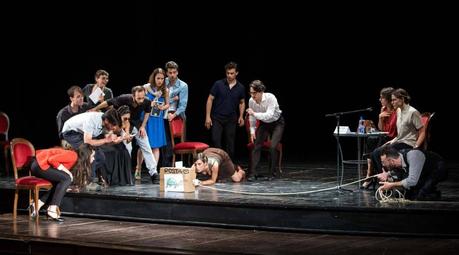Naples
The city of Naples has long been regarded as one of the most important cities in all Europe thanks to its rich history that stems back to the Neolithic period. As one of the oldest cities on the continent and the 3rd largest after Rome and Milan, it is often used as a stopover for those wanting to visit the ruins of Pompeii and Herculaneum. With Mt. Vesuvius looming in the distance, keeping a somewhat watchful eye over its residents, the city is a hotspot for tourists who eagerly venture out of the city to the base of the volcano, exploring its magnitude. If ever you find yourself in Naples for either of these activities, be sure to explore the chaotic and soulful city itself in all its old town glory.
Napoli Theatre Festival
The Naples Theatre Festival is an annual event founded in 2008. It’s now coming into its 12th edition and runs in the months of June and July. It’s organised by the Campania Festival Foundation with artistic director Ruggero Cappuccio leading the festival in new and innovative ways. The event is broken up into 12 sections, such as Literature, Music, Dance, Cinema, Exhibitions and International with over 150 events scheduled.
The magic of this festival is that it features in over 40 venues across Naples, so while the main venue is the Royal Palace of Naples, there are some other traditional and not so traditional locations that the festival performances will be held in. Some examples of this are the San Carlo Theatre, the roof of the Arts Academy, the undergrounds of Naples and Castel Sant Elmo. There are even some performances that could be set in whole neighbourhoods or abandoned places. The event this year starts on the 8th of June and you have until the 14th of July to see a performance. Some stand out shows this year are Macbeth, Othello and the Handmaid’s Tale. To entice the younger audiences, the cost of a ticket is priced at 8 euros.
Dopofestival- Puglia Village
The dopofestival is set yearly in the Romantic Garden at the Royal Palace and feature theater performances and dances unlike any other you’ve seen. Set in the spectacularly beautiful backdrop of the Romantic Garden, here you will find food tastings and open-air cinemas thanks to the partnership between Campania Festival Foundation and Pugliese Public Theatre.
The Puglia Village will share the finest food and wine from the Puglia region with the support of live music. This event is on from the 2nd to the 5th of July and begins with the Baluardo Live Tour, a powerful band that pushes boundaries with their music that will take listeners on a journey from Italy to mysteriously exotic places throughout the world. During the 4-day event, there will be a cooking demonstration on the 4th of July where you can learn about the classical Pugliese flavours of the region.
The last event in Puglia Village will be a musical set by the band The Kalascimas, whose eclectic mix of folk and electric music has captured the world stage. On the 5th of July, the band will perform hits from their latest album ‘K’ using a variety of instruments, some unique and some modern, closing the gap between Apulian music and the international music scene.
Pompeii Great Theatre
The theater area of Pompeii is one of the best-preserved attractions of the site, which conveniently allows it to become home to today’s plays and concerts. The theater at Pompeii is reminiscent of Greek-style theatres in that it is naturally set into the surface of the earth where it naturally inclines, making use of the terrain.
Small Theatre (Odeon)
Many who come to Pompeii don’t realize that there are two theatres to see at Pompeii; the small theater which could fit around 1,000 people which could be covered, and a larger, uncovered one. Theatre plays, much like gladiator battles in the Colosseum were free to attend, which made it a popular past time. The small theater was built in the 1st century BC and had a large wooden roof that was placed over the theater to better allow the sound to travel. Because of this, the main use for the small theater was for musical performances rather than plays. Much of the exterior walls of the theater is adorned with graffiti from spectators showing their appreciation for their favorite performances and performers.
Pompeii Theatrum Mundi
This year, the large theater will be the home of ancient Grecian plays by Sophocles and Euripides, much as it would have been thousands of years ago. In a collaboration between Teatro Stabile di Napoli and Campania Festival Foundation, the event will span over the months of June and July and showcase both theatrical performances and choreographed dances. The project was in the works for 4 years before its grand opening and this year the stage will be graced by performances of Paradise Lost, choreographer by Noa Wertheim, and The Oedipus at Colonus, presented by Ruggero Cappuccio who was inspired by the writings of Sophocles.
Great Theatre
The larger of the two theatres, the Great Theatre could hold a capacity of 5,000 spectators and was used as the main theater for plays such as comedies and tragedies. Whilst the smaller theater had a permanent roof lining, the larger one had a temporary cover which could be placed over the stage during performances. It was restored by two wealthy brothers who were locals of Pompeii that added marble to the surface of the stalls where spectators were sat. It’s known, however, that after the eruption of Vesuvius, the marble was carried away to use on other parts of the town. Two side boxes that were separated from where the general public sat for special guests of honor.
Advertisements

